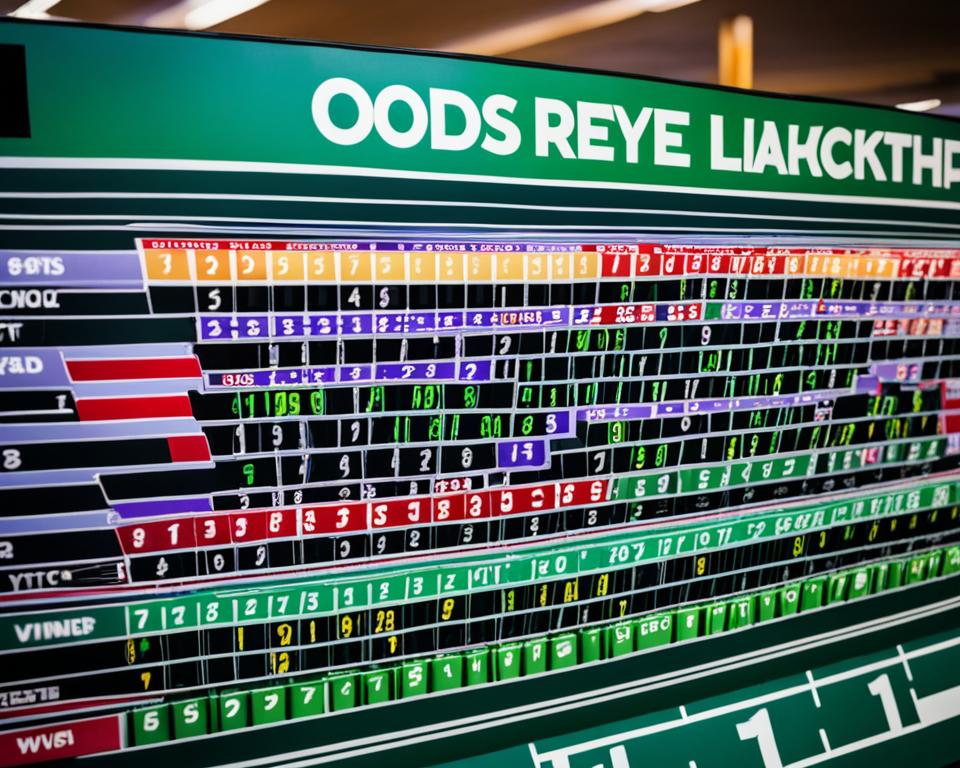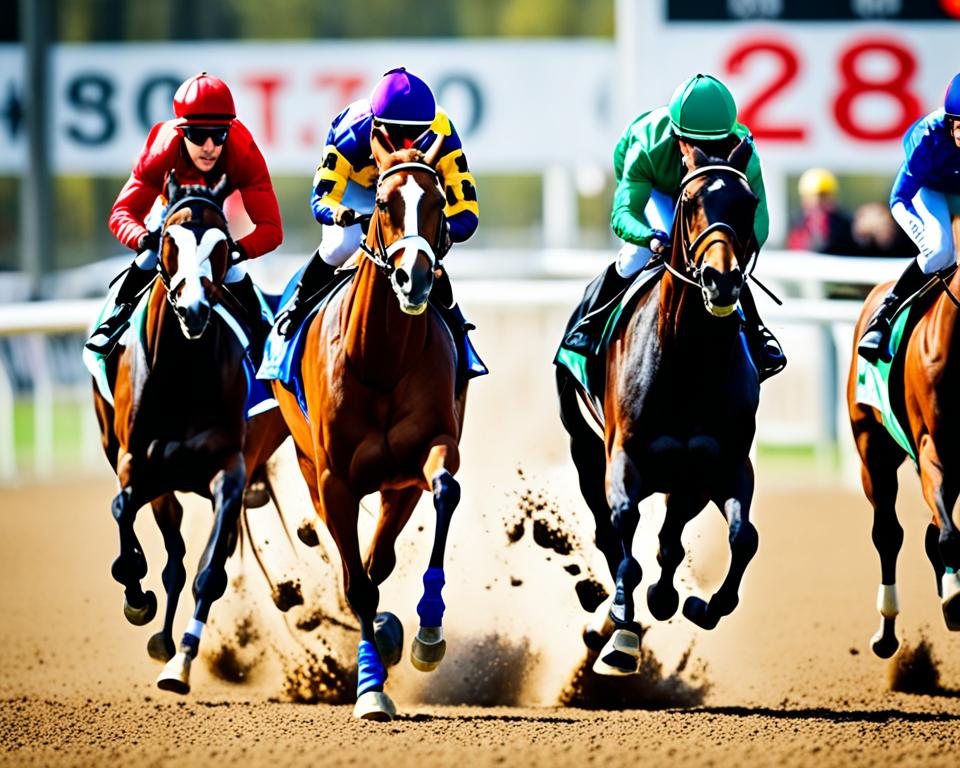Understanding horse racing odds is crucial for anyone interested in engaging in successful betting on the sport. This comprehensive guide aims to decode the meaning of horse racing odds and help readers comprehend the probability of each outcome in horse racing betting. By the end of this article, readers will have a clear grasp of how to interpret horse racing odds, calculate potential payouts, identify favorites and underdogs, and make informed betting decisions.
Read interesting things at : trainwithnexus
Key Takeaways
- Understand the fundamental concept of horse racing odds and their significance in betting.
- Learn to interpret different formats of horse racing odds, including fractional and decimal formats.
- Discover how to calculate potential payouts based on the odds and the amount wagered.
- Identify favorites and underdogs in horse races and how their odds reflect their chances of winning.
- Explore the factors that influence horse racing odds, such as horse and jockey performance, track conditions, and public betting patterns.
Introduction to Horse Racing Odds
Before delving into the intricacies of horse racing odds, it’s essential to understand the fundamental role they play in the world of equine betting. Odds are the cornerstone of every successful horse racing betting strategy, as they not only indicate the probability of a horse winning but also directly influence the potential payouts for bettors.
The Importance of Understanding Odds
For bettors to make informed decisions and maximize their returns, a comprehensive understanding of horse racing odds is paramount. By deciphering the meaning of odds, bettors can assess the likelihood of a horse’s victory, identify value bets, and develop effective wagering strategies. Mastering the art of understanding horse racing odds empowers bettors to navigate the dynamic landscape of the sport, giving them a competitive edge in the pursuit of profitable betting outcomes.
Types of Horse Racing Bets
The world of horse racing betting is vast and complex, with a myriad of bet types available to cater to the preferences and strategies of individual bettors. From the classic win, place, and show bets to the more intricate exacta, trifecta, and superfecta wagers, each bet type carries its own unique set of odds and potential payouts. Understanding the decoding horse racing odds associated with these various bet types is crucial for unpacking horse racing odds and maximizing the value of one’s betting portfolio.
what do horse racing odds mean
Deciphering the meaning of horse racing odds is essential for anyone looking to engage in successful betting. These numerical representations convey the probability of a horse winning a particular race, providing valuable insights that can inform your wagering decisions. By understanding horse racing odds, bettors can calculate potential payouts, identify favorites and underdogs, and make more informed choices when placing their bets.
Decoding the Odds Format
Horse racing odds are typically displayed in one of two primary formats: fractional odds and decimal odds. Fractional odds, commonly used in the United Kingdom, express the ratio of the amount you can win to the amount you bet. For example, odds of 5/2 (read as “five to two”) indicate that for every $2 you wager, you can potentially win $5 plus your original stake. Decimal odds, on the other hand, are more prevalent in the United States and present the total payout, including the original stake, for every $1 wagered.
Fractional Odds
Fractional odds are written as a ratio, such as 3/1 or 7/2. The first number represents the amount you can win, while the second number represents the amount you need to stake. For instance, odds of 3/1 mean that for every $1 you bet, you can potentially win $3 in addition to your original stake. Understanding the concept of fractional odds is crucial for interpreting the probability of a horse winning and calculating potential payouts.
Decimal Odds
Decimal odds, on the other hand, are expressed as a single number, such as 4.0 or 2.5. This number represents the total payout, including your original stake, for every $1 wagered. For example, odds of 4.0 indicate that for every $1 you bet, you can potentially win $4 (your original $1 plus $3 in winnings). Decimal odds provide a more straightforward way to understand horse racing odds and calculate potential returns.
Irrespective of the format used, understanding horse racing odds is crucial for making informed betting decisions and maximizing your potential returns. By familiarizing yourself with the nuances of fractional and decimal odds, you can better interpret the probability of a horse’s success and develop more effective betting strategies.
Horse Racing Odds Interpretation
As you delve deeper into the world of horse racing betting, a crucial skill to master is the interpretation of horse racing odds. These odds not only indicate the probability of a horse winning a race but also play a pivotal role in calculating potential payouts. In this section, we’ll explore the intricacies of understanding horse racing odds and how to leverage this knowledge to make informed betting decisions.
Calculating Potential Payouts
One of the primary benefits of understanding horse racing odds interpretation is the ability to calculate potential payouts. By analyzing the odds associated with a particular horse, you can determine the potential return on your wager. This information allows you to assess the risk and potential rewards of your bets, enabling you to make more strategic choices and maximize your returns.
Identifying Favorites and Underdogs
Another crucial aspect of horse racing odds interpretation is the ability to identify favorites and underdogs. Favorites, denoted by lower odds, represent horses with a higher probability of winning, while underdogs, with higher odds, have a lower perceived chance of victory. Understanding this concept can help you identify potential value bets and make more informed decisions when decoding horse racing odds.
Factors Influencing Horse Racing Odds
To make informed decisions when understanding horse racing odds, it’s crucial to recognize the various factors that can influence the odds. From the performance of the horses and jockeys to the track conditions and public betting patterns, these elements all play a significant role in shaping the odds for a particular race.
Horse and Jockey Performance
The horse racing odds are heavily influenced by the recent performance and form of the horses and jockeys. Factors such as a horse’s winning record, speed, stamina, and the jockey’s experience and riding style can all impact the perceived probability of a horse winning a race. Bettors who closely monitor these performance metrics can gain valuable insights when interpreting horse racing odds.
Track Conditions
The conditions of the racetrack can also significantly influence the odds. Factors like the surface (dirt, turf, or synthetic), the weather, and the track’s configuration can all affect the horses’ performance and, consequently, the odds. Savvy bettors will closely monitor the track conditions and adjust their understanding of the odds accordingly.
Public Betting Patterns
The betting patterns of the general public can also have a significant impact on horse racing odds. If a large number of bettors place wagers on a particular horse, the bookmakers may adjust the odds to balance their risk exposure. Monitoring these public betting trends can help bettors unpack the deeper meaning of the odds and identify potential value bets.

| Factor | Impact on Odds | Importance for Bettors |
|---|---|---|
| Horse and Jockey Performance | Heavily influential, as it reflects the perceived probability of a horse winning | Critical for understanding and interpreting horse racing odds |
| Track Conditions | Significantly impacts a horse’s performance and, consequently, the odds | Necessary for making sense of the odds and adjusting betting strategies |
| Public Betting Patterns | Can lead to bookmakers adjusting odds to balance risk exposure | Helpful for decoding the meaning of the odds and identifying value bets |
Horse Racing Betting Odds Explained
In the dynamic world of horse racing, understanding horse racing betting odds is paramount for making informed decisions and maximizing your potential returns. This comprehensive section delves into the key concepts and terminology that bettors must grasp to navigate the horse racing odds landscape with confidence.
At the heart of horse racing betting lies the odds, which represent the probability of a particular horse winning a race. These odds interpret the likelihood of an outcome, providing bettors with a crucial tool to assess the risks and potential rewards of their wagers. By unpacking the intricacies of horse racing odds, you’ll gain a deeper understanding of how to decode the probability of each outcome and make strategic betting choices.
From fractional odds to decimal odds, this section will guide you through the various formats in which horse racing odds are commonly displayed. You’ll learn how to calculate potential payouts, identify favorites and underdogs, and ultimately make more informed betting decisions that align with your risk tolerance and desired returns.
Furthermore, this section will explore the factors that influence horse racing odds, such as horse and jockey performance, track conditions, and public betting patterns. By understanding these key drivers, you’ll be better equipped to anticipate and respond to changes in the odds, leveraging your knowledge to identify valuable betting opportunities.
Whether you’re a seasoned horse racing enthusiast or a newcomer to the sport, this comprehensive section on horse racing betting odds will provide you with the tools and insights needed to navigate the complex world of horse racing betting with confidence and success.
Understanding Horse Racing Odds
As bettors strive to make informed decisions in the thrilling world of horse racing, understanding the nuances of odds is paramount. Two key aspects that deserve close attention are morning line odds and the dynamic changes and fluctuations that occur leading up to the race.
Morning Line Odds
The morning line odds, set by the racetrack’s oddsmaker, provide an initial indication of a horse’s perceived likelihood of winning. These odds reflect the expert’s assessment of the horses’ chances based on factors such as past performances, jockey and trainer records, and other relevant information. Paying close attention to the morning line can give bettors valuable insights into how the race is expected to unfold.
Odds Changes and Fluctuations
As the race approaches, horse racing odds can change and fluctuate significantly due to a variety of factors. Public betting patterns, late scratches, changes in track conditions, and even horse and jockey performance can all contribute to these dynamic odds changes. Savvy bettors learn to monitor these odds changes and interpret them to their advantage, identifying potential value bets and adjusting their strategies accordingly.
By understanding the significance of morning line odds and the factors that drive odds changes, bettors can develop a more nuanced appreciation for the complexities of horse racing odds. This knowledge empowers them to make more informed decisions, maximize their potential returns, and navigate the thrilling world of horse racing betting with greater confidence.
Horse Racing Odds Demystified
Navigating the complex world of horse racing odds can be a daunting task for many bettors, but understanding how to assess risk and value can be the key to unlocking profitable betting strategies. In this section, we will explore the nuances of horse racing odds demystified, providing you with the tools and insights needed to make informed decisions and maximize your returns.
Assessing Risk and Value
Effective horse racing odds interpretation involves more than just examining the numbers on the board. It requires a deep understanding of the factors that influence the odds and the ability to identify potential value bets. By analyzing the performance histories of horses, jockeys, and trainers, as well as considering track conditions and public betting patterns, you can gain a comprehensive understanding of the risks and potential rewards associated with each wager.
Recognizing value bets is a crucial skill in horse racing betting odds. Value bets are those where the potential payout exceeds the true probability of the horse winning, providing an edge over the bookmaker. By identifying these opportunities and strategically placing your wagers, you can maximize your long-term profits and minimize your exposure to unnecessary risk.
Bankroll Management Strategies
Effective bankroll management is essential for sustainable success in horse racing odds betting. Developing a disciplined approach to managing your bankroll, including setting betting limits, diversifying your wagers, and adjusting your stake sizes based on the odds and your risk tolerance, can help you navigate the ebbs and flows of the betting landscape.
By incorporating bankroll management strategies into your overall betting approach, you can ensure that your horse racing odds interpretation and decision-making process are not compromised by emotions or short-term volatility. This disciplined approach can help you maintain a long-term competitive edge and weather the inevitable ups and downs of the sport.
Making Sense of Horse Racing Odds
Navigating the world of horse racing odds can be a daunting task for bettors, but understanding how to compare them across different bookmakers is a critical skill. By identifying discrepancies in horse racing odds interpretation, you can uncover valuable betting opportunities and maximize your potential returns.
Comparing Odds Across Bookmakers
One of the key strategies for making sense of horse racing odds is to actively compare the offerings from various bookmakers. It’s not uncommon to find significant variations in the odds for the same race across different platforms. By carefully examining these differences, you can spot potential value bets and capitalize on bookmakers’ pricing disparities.
Identifying Betting Opportunities
Identifying betting opportunities in the horse racing odds landscape requires a keen eye and a solid understanding of the factors that influence odds. This may involve analyzing public betting patterns, assessing track conditions, and closely monitoring the performance of horses and jockeys. By combining this knowledge with a comparative analysis of odds, you can identify situations where the market has mispriced a horse, offering you a chance to secure more favorable horse racing odds and potentially higher payouts.
| Bookmaker | Horse A Odds | Horse B Odds | Horse C Odds |
|---|---|---|---|
| Bookmaker 1 | 3.5 | 6.0 | 10.0 |
| Bookmaker 2 | 4.0 | 5.5 | 9.5 |
| Bookmaker 3 | 3.75 | 5.75 | 9.75 |
By closely examining the horse racing odds offered by different bookmakers, you can identify potential betting opportunities and make more informed decisions about your wagers. Understanding the nuances of odds interpretation is the key to unlocking greater value in your horse racing bets.
Horse Racing Odds Guide
As you delve deeper into the world of horse racing betting, understanding the various horse racing odds concepts becomes paramount. This comprehensive guide will equip you with the knowledge to navigate the intricacies of what do horse racing odds mean, horse racing betting odds explained, understanding horse racing odds, horse racing odds interpretation, decoding horse racing odds, horse racing odds demystified, making sense of horse racing odds, horse racing odds guide, unpacking horse racing odds, horse racing odds 101.
Basic Odds Terminology
Let’s start with the fundamentals. In horse racing, odds are typically expressed in one of two formats: fractional odds (e.g., 5/1) or decimal odds (e.g., 6.00). Understanding the meaning and calculation behind these formats is crucial for interpreting the probability of a horse’s success and potential payouts.
Advanced Odds Concepts
Beyond the basic terminology, delving into more advanced odds concepts can provide bettors with a deeper understanding of the dynamics at play. Factors such as morning line odds, odds changes, and fluctuations can offer valuable insights into the perceived strengths and weaknesses of each horse, enabling you to make informed decisions and uncover potential betting opportunities.
By mastering the horse racing odds guide, you’ll be empowered to navigate the world of horse racing betting with confidence, leveraging your knowledge to make sense of horse racing odds and maximize your returns. Remember, the key to success lies in unpacking horse racing odds and applying that understanding to your betting strategies.
Unpacking Horse Racing Odds
As bettors navigate the world of horse racing, understanding the various types of odds is crucial for making informed decisions. This section delves into the specifics of unpacking horse racing odds, covering moneyline odds as well as exotic bets and their associated odds.
Moneyline Odds
Moneyline odds, also known as American odds, are the most straightforward type of horse racing odds. They represent the potential payout for a $100 wager on a particular horse. Positive moneyline odds, such as +200, indicate the amount of profit a bettor would earn from a $100 bet. Conversely, negative moneyline odds, such as -150, represent the amount a bettor would need to wager to win $100.
Interpreting moneyline odds is crucial for understanding horse racing odds and making sense of horse racing odds. Bettors can use these odds to calculate the implied probability of a horse winning and determine the value of their potential wagers.
Exotic Bets and Odds
In addition to moneyline bets, horse racing also offers a variety of exotic bets, such as exactas, trifectas, and superfectas. These bets require correctly predicting the order of finish for multiple horses in a single race. The odds for exotic bets are typically displayed as a payout amount for a $1 wager, rather than as a moneyline.
Unpacking the horse racing odds for exotic bets involves understanding the probability of correctly predicting the order of finish and the potential payouts. Bettors who can decode horse racing odds and unpack horse racing odds may find value in these more complex wagers, but they also come with a higher level of risk.
By mastering the interpretation of moneyline odds and exotic bet odds, bettors can make sense of horse racing odds and make more informed decisions when understanding horse racing odds and decoding horse racing odds. This knowledge can be a significant advantage in the pursuit of profitable horse racing betting.
Horse Racing Odds 101
Understanding horse racing odds is crucial for novice bettors looking to navigate the exciting world of equestrian wagers. In this section, we’ll provide a beginner’s guide to reading and interpreting these odds, along with practical examples and exercises to help you grasp the fundamentals.
Beginner’s Guide to Odds Reading
The first step in mastering horse racing odds is to familiarize yourself with the two primary formats: fractional odds and decimal odds. Fractional odds, commonly seen in the United States, are displayed as a ratio, such as 3/1 or 5/2. These odds represent the potential payout, where a $1 bet on a horse with 3/1 odds would return $4 (your original $1 stake plus $3 in winnings).
On the other hand, decimal odds, more prevalent in Europe, represent the total payout per $1 wagered. A horse with 4.0 decimal odds would pay out $4 for every $1 bet, including the original stake. Understanding these basic formats is crucial for interpreting horse racing odds and calculating potential returns.
Practice Examples and Exercises
To reinforce your understanding of horse racing odds, let’s explore a few practical examples:
| Horse | Fractional Odds | Decimal Odds | Implied Probability |
|---|---|---|---|
| Secretariat | 1/2 | 1.50 | 66.7% |
| Seabiscuit | 3/1 | 4.00 | 25.0% |
| Zenyatta | 5/2 | 3.50 | 28.6% |
In this example, Secretariat is the favorite with 1/2 fractional odds or 1.50 decimal odds, indicating a 66.7% implied probability of winning. Seabiscuit, with 3/1 fractional odds or 4.00 decimal odds, has a 25.0% implied probability, while Zenyatta’s 5/2 fractional odds or 3.50 decimal odds translate to a 28.6% implied probability.
By working through these practice examples, you’ll develop a deeper understanding of how to read and interpret horse racing odds, setting the foundation for more informed and confident betting decisions.
Decoding Horse Racing Odds
As we delve deeper into the world of horse racing, understanding the nuances of odds is paramount. In this final section, we will explore the underlying calculations and strategies that unlock the true value of horse racing odds.
Implied Probability Calculations
Odds in horse racing do not merely represent a potential payout; they also reflect the implied probability of a horse winning. By understanding how to calculate this implied probability, bettors can gain a more comprehensive understanding of the odds and make more informed decisions. Whether you’re analyzing what do horse racing odds mean or horse racing betting odds explained, mastering these calculations is a crucial step in unpacking horse racing odds and making sense of horse racing odds.
Identifying Value Bets
With a solid grasp of implied probability, bettors can then focus on identifying value bets – those wagers where the odds offer a higher potential return relative to the horse’s true chances of winning. By decoding horse racing odds and understanding horse racing odds interpretation, you’ll be able to spot undervalued horses and capitalize on the horse racing odds demystified, maximizing your potential for success in the long run.
| Horse | Odds | Implied Probability | Value Assessment |
|---|---|---|---|
| Secretariat | 1/5 | 83.3% | Favorite, slightly overvalued |
| Seabiscuit | 4/1 | 20% | Underdog, potential value bet |
| Cigar | 6/5 | 45.5% | Contender, fairly valued |
| Zenyatta | 3/2 | 40% | Favorite, potential value bet |
By decoding horse racing odds and understanding the underlying probabilities, bettors can make more informed decisions that align with their risk tolerance and betting strategies. This section has provided the tools and insights necessary to unpack horse racing odds and confidently navigate the complexities of the racetrack.
Mastering Horse Racing Odds
As bettors seeking to gain an edge in the dynamic world of horse racing, mastering the interpretation of odds is a critical skill. In this section, we will delve into advanced strategies for analyzing odds and leveraging odds data to make more informed and profitable betting decisions.
Advanced Strategies for Odds Interpretation
Beyond the fundamental understanding of fractional and decimal odds, seasoned bettors can employ more sophisticated techniques to extract greater value from the odds. This includes analyzing historical odds trends, identifying patterns in odds movements, and assessing the impact of key factors such as jockey changes, track conditions, and public sentiment on the shifting odds landscape.
By meticulously studying the odds, bettors can develop a deeper understanding of the underlying probabilities and uncover potential pricing inefficiencies in the market. This knowledge empowers them to identify value bets, spot favorable odds, and make more strategic wagers that maximize their potential returns.
Utilizing Odds Data for Analysis
The wealth of available odds data provides bettors with a treasure trove of information to inform their decision-making process. From tracking real-time odds updates to analyzing historical odds patterns, leveraging this data can give bettors a significant competitive advantage.
By closely monitoring odds movements, bettors can gain insights into the market’s sentiment, anticipate changes, and adjust their betting strategies accordingly. Moreover, utilizing advanced statistical analysis and data visualization techniques can unveil hidden trends and patterns that may elude casual observers.
Integrating odds data into a comprehensive betting strategy, along with other relevant factors such as horse and jockey performance, track conditions, and public betting patterns, allows bettors to make more informed and data-driven decisions that can lead to consistent and profitable results over the long run.

Conclusion
As we reach the end of our in-depth exploration of horse racing odds, it’s clear that understanding these crucial figures is the key to making informed and profitable betting decisions. Throughout this comprehensive guide, we’ve delved into the meaning of horse racing odds, the different formats in which they are presented, and the factors that influence them. By unpacking the horse racing odds and learning to interpret them effectively, readers now possess the knowledge and tools needed to confidently navigate the thrilling world of horse racing betting.
From calculating potential payouts to identifying favorites and underdogs, this article has provided a well-rounded understanding of horse racing odds and their practical application. Whether you’re a seasoned bettor or new to the sport, mastering the art of decoding horse racing odds will undoubtedly elevate your betting strategy and increase your chances of success. By making sense of horse racing odds and utilizing the insights gained, you’ll be equipped to identify value bets and make informed choices that maximize your returns.
As you continue your horse racing betting journey, remember that understanding horse racing odds is just the beginning. Stay vigilant, keep exploring the nuances of the sport, and let your newfound knowledge guide you towards more profitable and rewarding wagering experiences. Embrace the challenge, stay disciplined, and let this horse racing odds guide be your trusted companion on the path to mastering the exciting world of horse racing betting.


